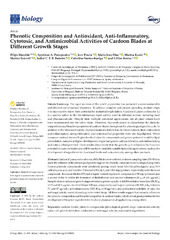Приказ основних података о документу
Phenolic Composition and Antioxidant, Anti-Inflammatory, Cytotoxic, and Antimicrobial Activities of Cardoon Blades at Different Growth Stages.
| dc.creator | Mandim, Filipa | |
| dc.creator | Petropoulos, Spyridon A. | |
| dc.creator | Pinela, José | |
| dc.creator | Dias, Maria Inês | |
| dc.creator | Kostić, Marina | |
| dc.creator | Soković, Marina | |
| dc.creator | Ferreira, Isabel C. F. R. | |
| dc.creator | Santos-Buelga, Celestino | |
| dc.creator | Barros, Lillian | |
| dc.date.accessioned | 2022-06-08T09:24:11Z | |
| dc.date.available | 2022-06-08T09:24:11Z | |
| dc.date.issued | 2022 | |
| dc.identifier.issn | 2079-7737 | |
| dc.identifier.uri | https://www.mdpi.com/2079-7737/11/5/699 | |
| dc.identifier.uri | http://radar.ibiss.bg.ac.rs/handle/123456789/4980 | |
| dc.description.abstract | Cardoon (Cynara cardunculus var. altilis) blades were collected at sixteen sampling dates (B1-B16) to study the influence of the phenological growth stage on the phenolic composition and biological properties. Twenty phenolic compounds were identified, among which trans 3,4-O-dicaffeoylquinic acid, 5-O-caffeoylquinic acid, and luteolin-O-hexoside (39.6, 42.6, and 101.0 mg/g extract, respectively) were the main compounds. Immature blades (B3) had a higher content of phenolic compounds (178 mg/g extract) and a greater ability to inhibit the formation of thiobarbituric acid reactive substances (IC50 of 1.61 µg/mL). Samples at more advanced growth stages revealed a greater capacity to inhibit oxidative hemolysis (B8, IC50 of 25 and 47.4 µg/mL for Δt of 60 and 120 min, respectively) and higher cytotoxic (B8-B13, GI50 between 7.1 and 17 µg/mL), anti-inflammatory (B13, IC50 of 10 µg/mL), and antibacterial activities. In turn, the antifungal activity varied depending on the tested fungi. All these results suggest that maturity influences the phenolic composition and bioactive properties of cardoon blades, which reveal great potential for the development of bioactive ingredients for food and pharmaceutical applications, among others. | |
| dc.publisher | Basel: MDPI | |
| dc.relation | info:eu-repo/grantAgreement/MESTD/inst-2020/200007/RS// | |
| dc.relation | Fundação para a Ciência e a Tecnologia | |
| dc.relation | Ministério da Ciência, Tecnologia e Ensino Superior | |
| dc.relation | European Regional Development Fund Norte-01-0145-FEDER-000042 | |
| dc.relation | Junta de Castilla y León | |
| dc.rights | openAccess | |
| dc.rights.uri | https://creativecommons.org/licenses/by/4.0/ | |
| dc.source | Biology | |
| dc.subject | Antibacterial/antifungal activity | |
| dc.subject | Antioxidant activity | |
| dc.subject | Cardoon blades | |
| dc.subject | Phenolic compounds | |
| dc.subject | Phenological growth stage | |
| dc.subject | Sustainable ingredients | |
| dc.subject | Tumor cell growth inhibition | |
| dc.title | Phenolic Composition and Antioxidant, Anti-Inflammatory, Cytotoxic, and Antimicrobial Activities of Cardoon Blades at Different Growth Stages. | |
| dc.type | article | en |
| dc.rights.license | BY | |
| dc.rights.holder | © 2022 by the authors. Licensee MDPI, Basel, Switzerland. | |
| dc.citation.issue | 5 | |
| dc.citation.volume | 11 | |
| dc.identifier.doi | 10.3390/biology11050699 | |
| dc.identifier.pmid | 35625427 | |
| dc.identifier.scopus | 2-s2.0-85129976460 | |
| dc.identifier.wos | 000803319000001 | |
| dc.citation.apa | Mandim, F., Petropoulos, S. A., Pinela, J., Dias, M. I., Kostic, M., Soković, M., et al. (2022). Phenolic Composition and Antioxidant, Anti-Inflammatory, Cytotoxic, and Antimicrobial Activities of Cardoon Blades at Different Growth Stages. Biology, 11(5), 699. | |
| dc.citation.vancouver | Mandim F, Petropoulos SA, Pinela J, Dias MI, Kostic M, Soković M, Ferreira ICFR, Santos-Buelga C, Barros L. Phenolic Composition and Antioxidant, Anti-Inflammatory, Cytotoxic, and Antimicrobial Activities of Cardoon Blades at Different Growth Stages. Biology (Basel). 2022;11(5):699. | |
| dc.citation.spage | 699 | |
| dc.type.version | publishedVersion | |
| dc.identifier.fulltext | https://radar.ibiss.bg.ac.rs/bitstream/id/10621/biology-11-00699-v3.pdf | |
| dc.citation.rank | M21 |

